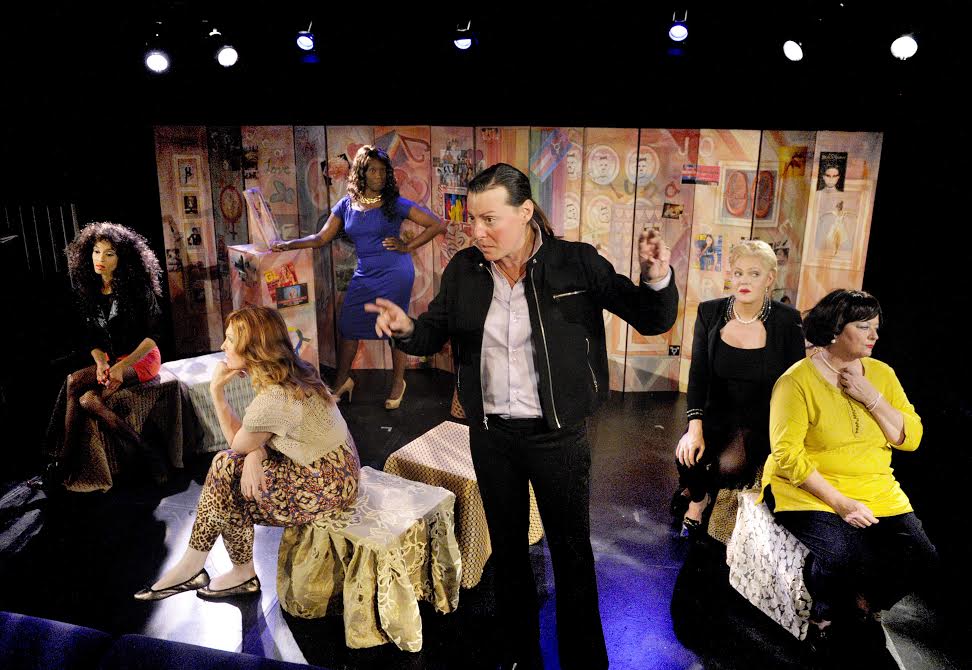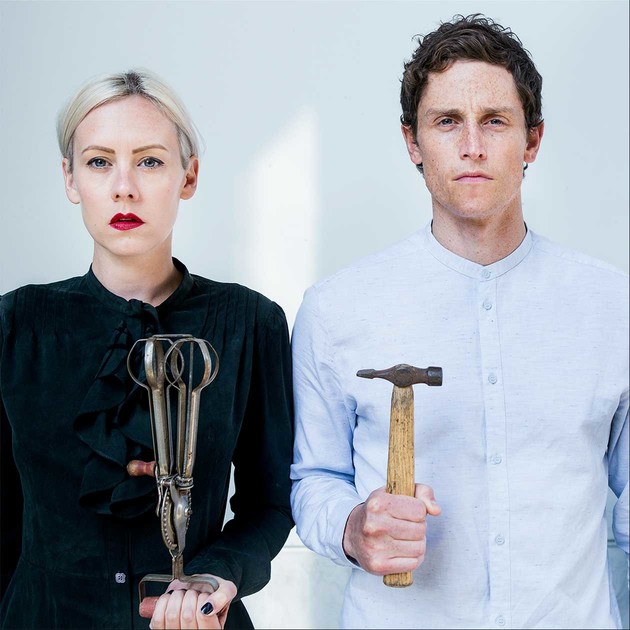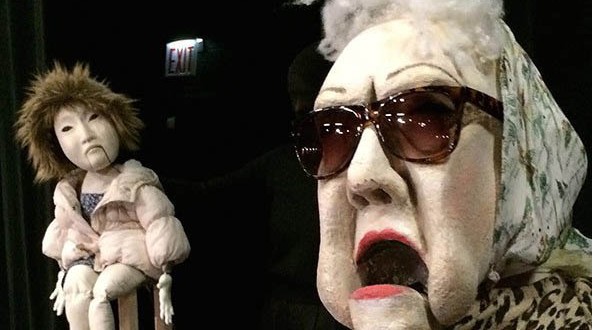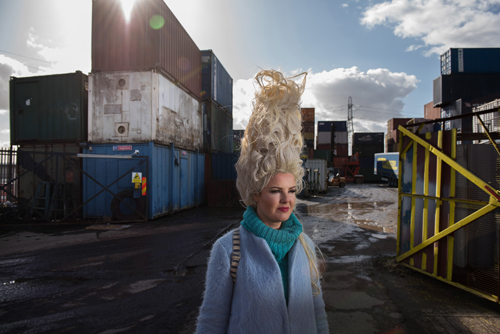Ah, the lure of the silver screen! Close Up starts with slow motion, Black and white film of diving and tumbling bodies, enormous limbs and torsos travelling across the large screen to the rear of the performance space, which is set up dance-style at floor level – no staging, tiered seats rising up on three sides. Real live bodies enter from around and behind the screen, unlit other than by the light of the screen, crossing the stage in low rolls and dives and scuttles.
The onscreen images dissolve and instead a spotlight highlights a man in a black suit and white shirt, wearing black and white spats. His silhouette is cast upon the screen in the full moon circle of the spotlight. The tone shifts, the man speaks. He introduces himself: he’s Dan from Melba, and he’s a hand-balancer. He proves this with a very beautiful and skilled hand-balancing sequence. And adds a dash of the Donnie Darko theme on guitar…
The four performers take turns on the mic, reciting a litany of action verbs ‘to jump, to tumble, to rock, to roll’ as they leap and fly across the floor. They run into the audience with their mics, chatting and flirting with audience members – getting close to people, you could say. Lauren is close to me, sitting on a man’s lap, having a photo taken with him. When she’s not seducing people, she’s challenging the feminine stereotype by basing not one not two but three other people, or by performing a stunningly strong corde lisse act – the free-hanging rope being more closely associated with male performers, women traditionally going for silks or trapeze. The other two performers on stage and screen are Lewie who is an ace hula-hooper, amongst other talents, and Todd, who is a Chinese Pole performer. The show is punctuated with autobiographical details, and a kind of demystifying of processes: ‘This is one of those moments called a transition, when we need to put up the Chinese Pole’ says Todd ‘ So I’m going to put on my Pole clothes, which I need to protect me from skin burns… but this jumper is just an ordinary jumper, from H&M I think. They’re not sponsoring us…’ He then moves into a breathtaking, perfectly times Chinese Pole act.
Elsewhere, we get more evidence of the extraordinary skills and acts we’ve come to expect from Circa. My favourite section starts with a row of chairs. There’s a lovely playful scene as four people are brought up from the audience to sit upright and still as the four performers move around and over them and the chairs, a beautiful exploration of what it is to perform and what it is to witness, to really look. Then, each performer takes his or her audience partner by the hand and invites them into a gentle waltz. All lovely stuff. Partners are returned to their seats, and the chairs continue to play their part, becoming a great tower climbed up and balanced on – a great merging of object manipulation and equilibrist skills.
Meanwhile, we return now and again to the screen. There’s close-ups of taut stomachs beaten percussively with fists, and a kind of time-lapsed animation of Lewie hooping, as live she takes more and more colourful hoops onto her gyrating body.
Close Up is a show about the gaze; about looking from near and from far; about seeing and being seen. But dramaturgically speaking, it’s not quite there yet. Of course the skills are amazing – this is Circa, world leaders in contemporary circus. And much of the content of the piece is in place, and interesting. Many of the set pieces incorporated are really beautiful, and I love the play with audience, the exploration of ‘near’ and ‘far’. I’m not so keen on the confessional-autobiographical moments, nor on the deconstructing commentary on circus. Both of these things have been done better by others. The main criticism, though, is of the film work, which seems so crucial to the content of Close Up – the gaze, the mediated image – yet is just not that interesting, for the most part. I suppose we are all so used to slow-mo action and close-ups of acrobats’ or dancers’ body parts used in advertising that it takes something radically different to really grab our attention. That said, the ending – which involves the screen – is wonderful!
I suppose I am also, in my criticisms, influenced by the experience of seeing two of these four performers very recently in the other Circa show that premiered this year: What Will Have Been, which even on the occasion of its premiere was so wonderful, so perfectly formed, that it would be beyond all reason if director Yaron Lifschitz and the ensemble could have pulled off a second perfect show within a few months. I am also reminding myself that I had reservations about Circa’s Beyond on its first outing, and on seeing it a second and third time over two years watched it evolve into one of the best-ever Circa shows. The note here is that with Circa, as with all of us, some shows arrive almost fully formed on their first outings, everything slipping into place effortlessly; and with other shows there is a longer gestational process before the piece is at its best. This is the premiere of an adventurous show, involving a number of elements beyond the regular circus tool-box (moving image, spoken text, audience participation) and it will grow and grow, I am sure.
Of course, even a work-in-progress from Circa is heads above most circus shows out there. The full house of Underbelly’s big purple cow on the opening night of the Fringe is ecstatic to have been invited into this very special world of supreme talent and stimulating ideas, and gives the fab four performers the ovation they deserve.





